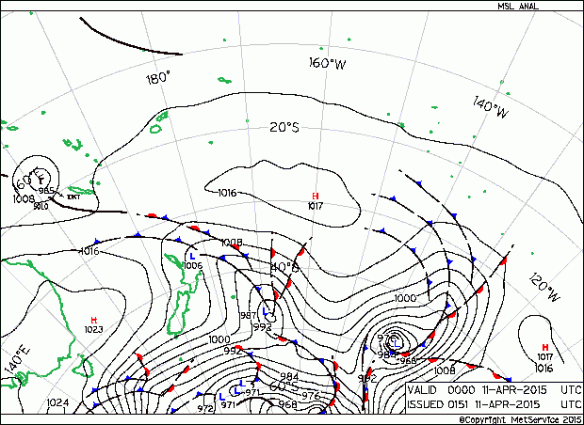Position: 34 degrees, 43 minutes south; 179 degrees, 18 minutes WEST
We’re headed across the South Pacific the way Polynesia was colonized centuries ago. More on that below, but first some other thoughts.
We crossed over the date line this afternoon. We’re now in west lattitudes. Funny, I don’t feel any different. Well, a little younger maybe. I wonder if when the ancient Polynesians did this, they had to reset their, um, oh nevermind.
We did about 120 nautical miles yesterday. One thing about cruising – you can sail the boat faster if you want to, but both you and the boat will wear out. Yesterday was a good example. We probably could have done 150 miles, but given that we use a wind vane to steer Charisma 24/7, we have to trim the boat to the “gust factor” and not to the average wind or the vane gets “overpowered” in the gusts and we go out of control. Usually this just means we “round up” and the sails shake and the rig rattles, but the wear and tear is cumulative and not desirable. In fact, I would guess that we’re only really trimmed properly for the wind about 30% of the time, which is the time we spent in the gusting range of the wind. The other 70% of the time we’re either slightly underpowered or quite underpowered in the lower ranges of the wind. Thus, with a wind vane you accept a little “wandering” and maybe you don’t go as far as if you stood out there all day long and “hand” steered. Amazingly though, even if you watch the compass and see that you can be wandering off course by 20 or more degrees at times, somehow over a hundred miles or so when you really look at where you are, you are spot on. It all averages out I guess.
So, about those Polynesian settlers. The islands from Fiji all the way east through Tahiti and north to Hawaii were populated by people who migrated eastbound against the prevailing wind by noticing the same thing we have – that even though the predominant wind in the South Pacific is easterly (flows from east to west), when a low pressure system comes through you get south and westerly winds that counter the flow. That’s how we hope to go “against” the prevailing winds to get to Tahiti. Ride the top of lows that come through. The winds go clockwise around the low over an area hundreds of miles wide, so over a large area you can get south and west winds for some days. When the low goes too far past, you have to wait for the next one to get the same boost. A tougher ride than the “milkrun” down here, but an interesting one since we’re following an ancient historic migration path.

Here's the "plan". You can just see New Zealand outlined in green on the middle left. As you go east (to the right) you can see two low pressure systems. The wind flows approximately in line with the lines defining pressure gradients. Wind circulates Clockwise around lows in the southern hemisphere, so you can see how we can "ride" a west wind to the east. Tahiti is the little "green smudge" approx 17degrees south, 150 degrees west.
